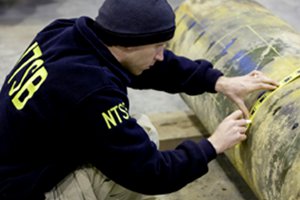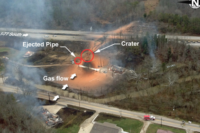
|
Columbia Gas controller received more than a dozen alerts about a pressure drop in a natural gas pipeline, but it was a field technician from another gas company who notified the controller about a rupture that released natural gas and led to a fire that destroyed homes and shut down a major freeway.
That is one of the findings of a National Transportation Safety Board (NTSB) preliminary report into the Dec. 11, 2012, rupture of a natural gas transmission line in Sissonville, W.Va.
To date, the NTSB's investigation has found:
• At about 12:41 p.m., a buried 20-inch diameter natural gas transmission pipeline (Line SM-80), owned and operated by Columbia Gas Transmission Corporation ruptured near Route 21 and Derricks Creek, and about 112 feet west of Interstate 77 in Sissonville, W.Va. About 20 feet of pipe was separated and ejected from the underground pipeline and landed more than 40 feet from its original location. The pipeline maximum allowable operating pressure was 1,000 pounds per square inch gauge, and the operating pressure at the time of the rupture was about 929 psig.
• The rupture occurred in a pipe that was a part of a pipeline segment installed in 1967 with an original, nominal wall thickness of 0.281 inches. The 20-foot ejected section of the pipe was fractured in the base metal along the entire longitudinal direction along the bottom of the pipe. The outside surface of the pipe was heavily corroded near the midpoint and along the longitudinal fracture. The thinned area was approximately 6 feet in the longitudinal direction and 2 feet in the circumferential direction. The lowest wall thickness measured was 0.078 inches.
• After the escaping high-pressure natural gas ignited, fire damage extended nearly 1,100 feet along the pipeline and was about 820 feet wide. Three homes were destroyed by the fire, and several other homes were damaged. Interstate 77 was closed in both directions for about 18 hours until the roadway surfaces were repaired.
• The first notification to the Columbia Gas control center was received from a controller from another gas company, who had received a report of a rupture and fire from a field technician who was near the accident location. Prior to the call from the other company, the Columbia Gas controller received 16 pressure drop alerts.
A link to the full preliminary report can be found at: http://go.usa.gov/4grH
Additional reports, analysis and a finding of probable cause will come later in the investigation.



